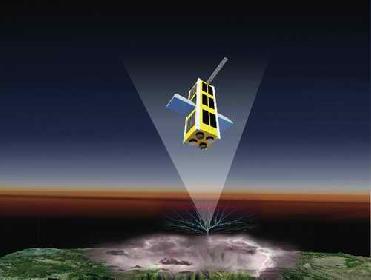
The 'Firefly' satellite will probe the terrestrial gamma ray flashes. Photo credit: USRA
WASHINGTON (BNS): 'Firefly', a small satellite mission likely to be launched in 2010 or 2011, would unravel the mystery of the most powerful natural particle accelerator in the Earth's atmosphere -- terrestrial gamma-ray flashes.
Unlike the well-known flashes of light and peals of thunder familiar to Earth-dwellers, these energy releases are channeled upward and can be detected only from space. The atmosphere protects humans from the effects of this radiation, but the mechanisms at work can impact Earth's upper atmosphere and its space environment.
Sponsored by the National Science Foundation (NSF) and led by NASA's Goddard Space Flight Center in Greenbelt, Maryland, the nano satellite will explore the relationship between lightning and the sudden bursts, called terrestrial gamma ray flashes (TGFs).
"These electron beams are more powerful than any produced in near-Earth space, and understanding their acceleration mechanisms will shed light on a physical process that may occur on other planets, or in astrophysical environments, as well as in the sun's corona," said Doug Rowland, principal investigator for the Firefly mission at NASA’s Goddard Space Weather Laboratory.
Firefly will explore which types of lightning produce these electron beams and associated TGFs. In addition, it will also explore the occurrence rate of TGFs that are weaker than any studied previously. Scientists hope the result would aid in understanding better the effect millions of lightning flashes that occur worldwide each day, have on the Earth's upper atmosphere and near-Earth space environment.
The Firefly mission is the second project under the new NSF CubeSat programme. A CubeSat satellite, about the size of a loaf of bread, consists of three cubes attached end-to-end in a rectangular shape.
NSF Deputy Director Kathie L Olsen said that integrating innovative and creative educational efforts with front-line research is what NSF is all about. "The new CubeSat programme uses the transformational technology of CubeSats to do just that. The Firefly mission is a terrific example of a programme that will pursue scientific discovery, while providing unique and inspiring educational opportunities.”
“This mission could provide the first direct evidence for the relationship between lightning and TGFs, and addresses an important research question in atmospheric electricity,” said Head of NSF's Atmospheric Sciences Division's Lower Atmosphere Research Section, Anne-Marie Schmoltner.
"Identifying the source of terrestrial gamma ray flashes would be a great step toward (in) fully understanding the physics behind lightning and its effect on the Earth's atmosphere," Schmoltner said. To accomplish these goals, Firefly will carry a gamma-ray detector along with a suite of instruments to detect lightning, she added.
 Previous Article
Previous Article













The Indian Air Force, in its flight trials evaluation report submitted before the Defence Ministry l..
view articleAn insight into the Medium Multi-Role Combat Aircraft competition...
view articleSky enthusiasts can now spot the International Space Station (ISS) commanded by Indian-American astr..
view article